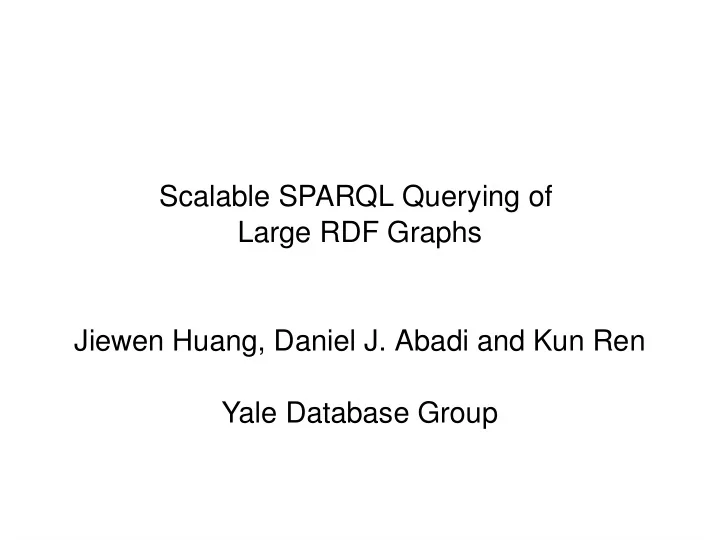

Scalable SPARQL Querying of Large RDF Graphs Jiewen Huang, Daniel J. Abadi and Kun Ren Yale Database Group
RDF Gaining Popularity ● Encouraged by major search engines Google Yahoo! ● More data sets available in RDF ● Governments ● Research communities
Linked Data Movement
Scalable Processing ● Single-node RDF management systems are abundant ● Sesame ● Jena ● RDF-3X ● 3store ● Research in clustered RDF management is less significantly explored: The focus of the talk
RDF as Triples and a Graph
SPARQL ● RDF query language ● A basic graph pattern ● Answering SPARQL can be seen as finding subgraphs in the RDF data that match the graph pattern
Example for Star Pattern ● Find the names of the strikers that play for FC Barcelona. SELECT ?name WHERE { ?player type footballer . ?player name ?name . ?player position striker . ?player playsFor FC_Barcelona . }
Another Example ● Find football players playing for clubs in a populous region where they were born.
System Architecture
Data Partitioning ● Hash vs Graph partitioning ● Hash: Only efficient for star patterns ● Graph: Taking advantage of graph model ● Edge vs Vertex partitioning ● Edge: Natural but inefficient for query execution ● Vertex: Superior for common graph patterns
Edge/Triple Placement ● Minimizing data shuffling/exchange ● Allowing data overlap ● N-hop guarantee ● The extent of data overlap ● If a vertex is assigned to a machine, any vertex that is within n-hop of this vertex is also stored in this machine
Example for N-Hop Guarantee
Query Processing ● Query execution is more efficient in RDF-stores than in Hadoop ● Pushing as much of the processing as possible into RDF-stores ● Minimizing the number of Hadoop jobs ● The larger the hop guarantee, the more work is done in RDF-stores
To Communicate, or not to Communicate ● Given a query and n-hop guarantee, is communication (Hadoop job) between nodes needed? ● Choose the “center” of the query graph ● Calculate the distance from the “center” to the furthest edge ● If distance > n, communication is needed; not needed otherwise
Back to the Example ● Find football players playing for clubs in a populous region where he was born.
Experimental Setup ● 20-machine cluster ● Leigh University Benchmark (LUBM): 270 million triples ● Competitors: ● Single-node RDF-3X ● SHARD: triple-store system in Hadoop ● Graph partitioning (the proposed system) ● Hash partitioning on subjects
Performance Comparison
Speedup ● Better than linear speedup
Summary ● We propose a new architecture for scalable RDF data management: RDF-stores + Hadoop ● We propose a new approach for data placement and corresponding query processing: Graph partitioning + N-hop guarantee ● The techniques in the talk can be generalized to the problems of subgraph pattern matching in other graphs ● The lesson we learned: Inter-node communication is expensive, avoid it.
Thank you!
Backup Slides: Optimization ● Problem: High-degree vertexes make the graph well-connected and difficult to partition ● Solution: Removing them in graph partitioning ● Problem: High-degree vertexes cause data explosion in n-hop guarantee ● Solution: Weakened n-hop guarantee
Recommend
More recommend